Attached files
| file | filename |
|---|---|
| EX-99.1 - EX-99.1 - Avery Dennison Corp | d167347dex991.htm |
| 8-K - 8-K - Avery Dennison Corp | d167347d8k.htm |
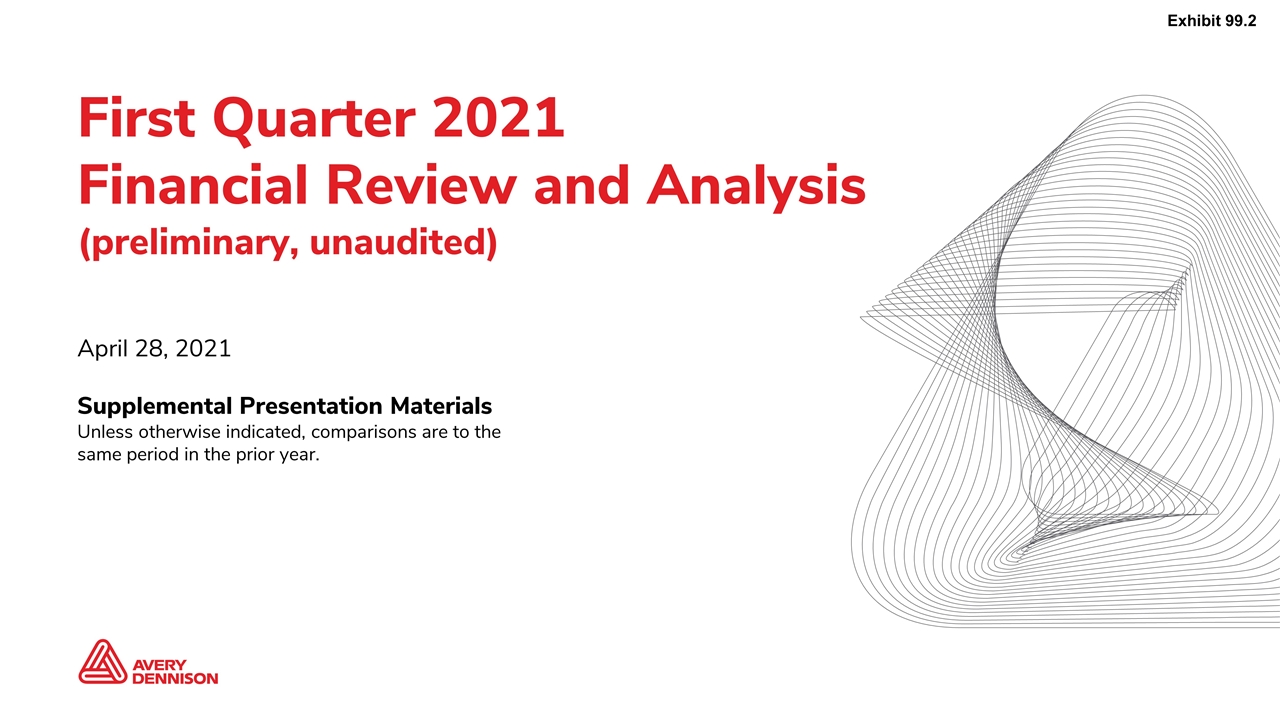
First Quarter 2021 Financial Review and Analysis (preliminary, unaudited) April 28, 2021 Supplemental Presentation Materials Unless otherwise indicated, comparisons are to the same period in the prior year. Exhibit 99.2

Safe Harbor Statement Certain statements contained in this document are "forward-looking statements" intended to qualify for the safe harbor from liability established by the Private Securities Litigation Reform Act of 1995. These forward-looking statements, and financial or other business targets, are subject to certain risks and uncertainties. We believe that the most significant risk factors that could affect our financial performance in the near-term include: (i) the impacts to underlying demand for our products and/or foreign currency fluctuations from global economic conditions, political uncertainty, changes in environmental standards and governmental regulations, including as a result of the coronavirus/COVID-19 pandemic; (ii) competitors’ actions, including pricing, expansion in key markets, and product offerings; (iii) the degree to which higher costs can be offset with productivity measures and/or passed on to customers through price increases, without a significant loss of volume; and (iv) the execution and integration of acquisitions. Actual results and trends may differ materially from historical or anticipated results depending on a variety of factors, including but are not limited to, risks and uncertainties relating to the following: COVID-19 International Operations – worldwide and local economic and market conditions; changes in political conditions; and fluctuations in foreign currency exchange rates and other risks associated with foreign operations, including in emerging markets. Our Business – changes in our markets due to competitive conditions, technological developments, environmental standards, laws and regulations, and customer preferences; fluctuations in demand affecting sales to customers; execution and integration of acquisitions; selling prices; fluctuations in the cost and availability of raw materials and energy; the impact of competitive products and pricing; customer and supplier concentrations or consolidations; financial condition of distributors; outsourced manufacturers; product and service quality; timely development and market acceptance of new products, including sustainable or sustainably-sourced products; investment in development activities and new production facilities; successful implementation of new manufacturing technologies and installation of manufacturing equipment; our ability to generate sustained productivity improvement; our ability to achieve and sustain targeted cost reductions; and collection of receivables from customers. Income Taxes – fluctuations in tax rates; changes in tax laws and regulations, and uncertainties associated with interpretations of such laws and regulations; retention of tax incentives; outcome of tax audits; and the realization of deferred tax assets. Information Technology – disruptions in information technology systems, including cyber-attacks or other intrusions to network security; successful installation of new or upgraded information technology systems; and data security breaches. Human Capital – recruitment and retention of employees; fluctuations in employee benefit costs; and collective labor arrangements. Our Indebtedness – credit risks; our ability to obtain adequate financing arrangements and maintain access to capital; volatility of financial markets; fluctuations in interest rates; and compliance with our debt covenants. Ownership of Our Stock – potential significant variability of our stock price and amounts of future dividends and share repurchases. Legal and Regulatory Matters – protection and infringement of intellectual property and impact of legal and regulatory proceedings, including with respect to environmental, health and safety, anti-corruption and trade compliance. Other Financial Matters – fluctuations in pension costs and goodwill impairment. For a more detailed discussion of these factors, see “Risk Factors” and “Management’s Discussion and Analysis of Financial Condition and Results of Operations” in our 2020 Form 10-K, filed with the Securities and Exchange Commission on February 25, 2021. The forward-looking statements included in this document are made only as of the date of this document, and we undertake no obligation to update these statements to reflect subsequent events or circumstances, other than as may be required by law.
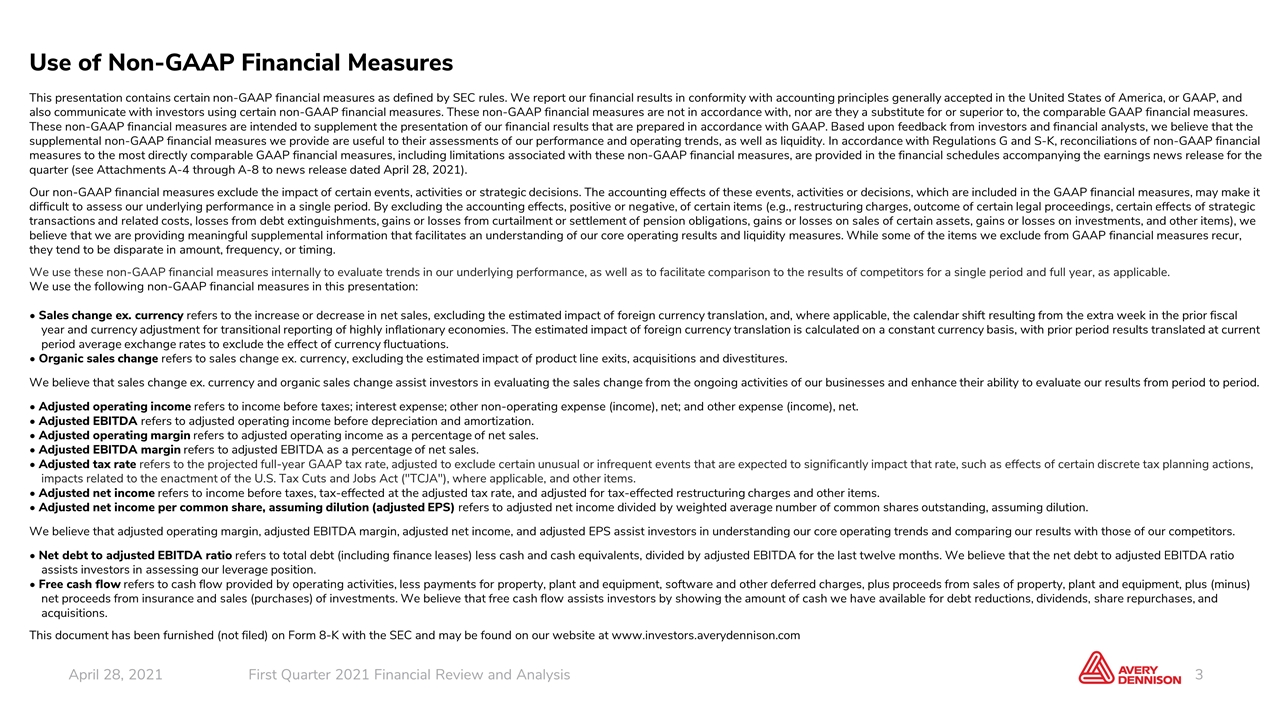
Use of Non-GAAP Financial Measures This presentation contains certain non-GAAP financial measures as defined by SEC rules. We report our financial results in conformity with accounting principles generally accepted in the United States of America, or GAAP, and also communicate with investors using certain non-GAAP financial measures. These non-GAAP financial measures are not in accordance with, nor are they a substitute for or superior to, the comparable GAAP financial measures. These non-GAAP financial measures are intended to supplement the presentation of our financial results that are prepared in accordance with GAAP. Based upon feedback from investors and financial analysts, we believe that the supplemental non-GAAP financial measures we provide are useful to their assessments of our performance and operating trends, as well as liquidity. In accordance with Regulations G and S-K, reconciliations of non-GAAP financial measures to the most directly comparable GAAP financial measures, including limitations associated with these non-GAAP financial measures, are provided in the financial schedules accompanying the earnings news release for the quarter (see Attachments A-4 through A-8 to news release dated April 28, 2021). Our non-GAAP financial measures exclude the impact of certain events, activities or strategic decisions. The accounting effects of these events, activities or decisions, which are included in the GAAP financial measures, may make it difficult to assess our underlying performance in a single period. By excluding the accounting effects, positive or negative, of certain items (e.g., restructuring charges, outcome of certain legal proceedings, certain effects of strategic transactions and related costs, losses from debt extinguishments, gains or losses from curtailment or settlement of pension obligations, gains or losses on sales of certain assets, gains or losses on investments, and other items), we believe that we are providing meaningful supplemental information that facilitates an understanding of our core operating results and liquidity measures. While some of the items we exclude from GAAP financial measures recur, they tend to be disparate in amount, frequency, or timing. We use these non-GAAP financial measures internally to evaluate trends in our underlying performance, as well as to facilitate comparison to the results of competitors for a single period and full year, as applicable. We use the following non-GAAP financial measures in this presentation: • Sales change ex. currency refers to the increase or decrease in net sales, excluding the estimated impact of foreign currency translation, and, where applicable, the calendar shift resulting from the extra week in the prior fiscal year and currency adjustment for transitional reporting of highly inflationary economies. The estimated impact of foreign currency translation is calculated on a constant currency basis, with prior period results translated at current period average exchange rates to exclude the effect of currency fluctuations. • Organic sales change refers to sales change ex. currency, excluding the estimated impact of product line exits, acquisitions and divestitures. We believe that sales change ex. currency and organic sales change assist investors in evaluating the sales change from the ongoing activities of our businesses and enhance their ability to evaluate our results from period to period. • Adjusted operating income refers to income before taxes; interest expense; other non-operating expense (income), net; and other expense (income), net. • Adjusted EBITDA refers to adjusted operating income before depreciation and amortization. • Adjusted operating margin refers to adjusted operating income as a percentage of net sales. • Adjusted EBITDA margin refers to adjusted EBITDA as a percentage of net sales. • Adjusted tax rate refers to the projected full-year GAAP tax rate, adjusted to exclude certain unusual or infrequent events that are expected to significantly impact that rate, such as effects of certain discrete tax planning actions, impacts related to the enactment of the U.S. Tax Cuts and Jobs Act ("TCJA"), where applicable, and other items. • Adjusted net income refers to income before taxes, tax-effected at the adjusted tax rate, and adjusted for tax-effected restructuring charges and other items. • Adjusted net income per common share, assuming dilution (adjusted EPS) refers to adjusted net income divided by weighted average number of common shares outstanding, assuming dilution. We believe that adjusted operating margin, adjusted EBITDA margin, adjusted net income, and adjusted EPS assist investors in understanding our core operating trends and comparing our results with those of our competitors. • Net debt to adjusted EBITDA ratio refers to total debt (including finance leases) less cash and cash equivalents, divided by adjusted EBITDA for the last twelve months. We believe that the net debt to adjusted EBITDA ratio assists investors in assessing our leverage position. • Free cash flow refers to cash flow provided by operating activities, less payments for property, plant and equipment, software and other deferred charges, plus proceeds from sales of property, plant and equipment, plus (minus) net proceeds from insurance and sales (purchases) of investments. We believe that free cash flow assists investors by showing the amount of cash we have available for debt reductions, dividends, share repurchases, and acquisitions. This document has been furnished (not filed) on Form 8-K with the SEC and may be found on our website at www.investors.averydennison.com

First Quarter 2021 Review Strong start to the year across portfolio; raising outlook for 2021 Reported sales increased 19% Sales growth ex. currency (non-GAAP) of 11%; organic sales growth (non-GAAP) of 9% Volume higher than anticipated across segments (incl. benefit from pre-buy) Intelligent Labels momentum continues; sales up ~40% ex. currency and ~20% organically Reported operating margin of 13.8%, up 220 bps Adj. EBITDA margin (non-GAAP) of 16.5%, adj. operating margin (non-GAAP) of 13.9%, both up ~2 pts. as higher volume and productivity drove significant margin expansion in every segment Inflation higher than expected in Q1 and Q2; pricing actions being implemented to offset higher costs Belt-tightening cost reductions (e.g., T&E) remained in the quarter; expected to largely return in 2H Reported EPS of $2.50, up 56%; adj. EPS (non-GAAP) of $2.40, up 45%, above expectations FY21 adj. EPS guidance raised to $8.40 to $8.80, reflecting higher full-year growth assumption Increased organic sales growth outlook to 8% to 10% Adj. EPS up ~20% compared to prior year
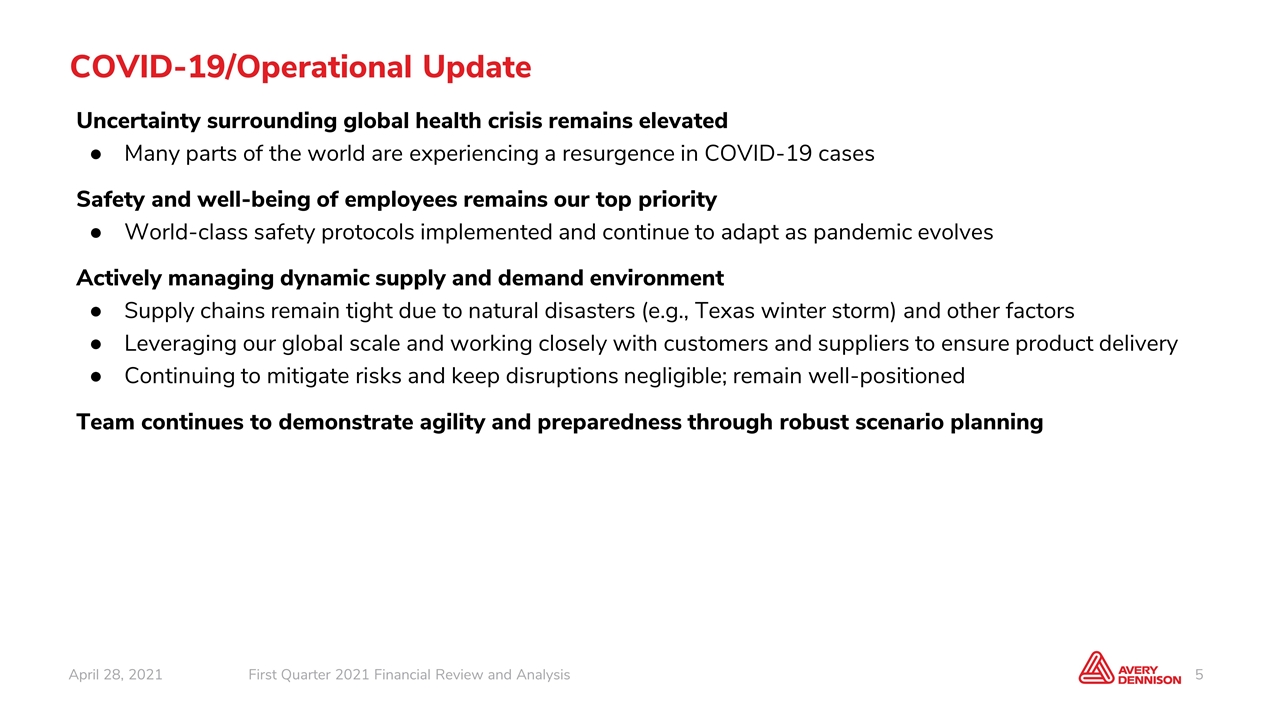
COVID-19/Operational Update Uncertainty surrounding global health crisis remains elevated Many parts of the world are experiencing a resurgence in COVID-19 cases Safety and well-being of employees remains our top priority World-class safety protocols implemented and continue to adapt as pandemic evolves Actively managing dynamic supply and demand environment Supply chains remain tight due to natural disasters (e.g., Texas winter storm) and other factors Leveraging our global scale and working closely with customers and suppliers to ensure product delivery Continuing to mitigate risks and keep disruptions negligible; remain well-positioned Team continues to demonstrate agility and preparedness through robust scenario planning
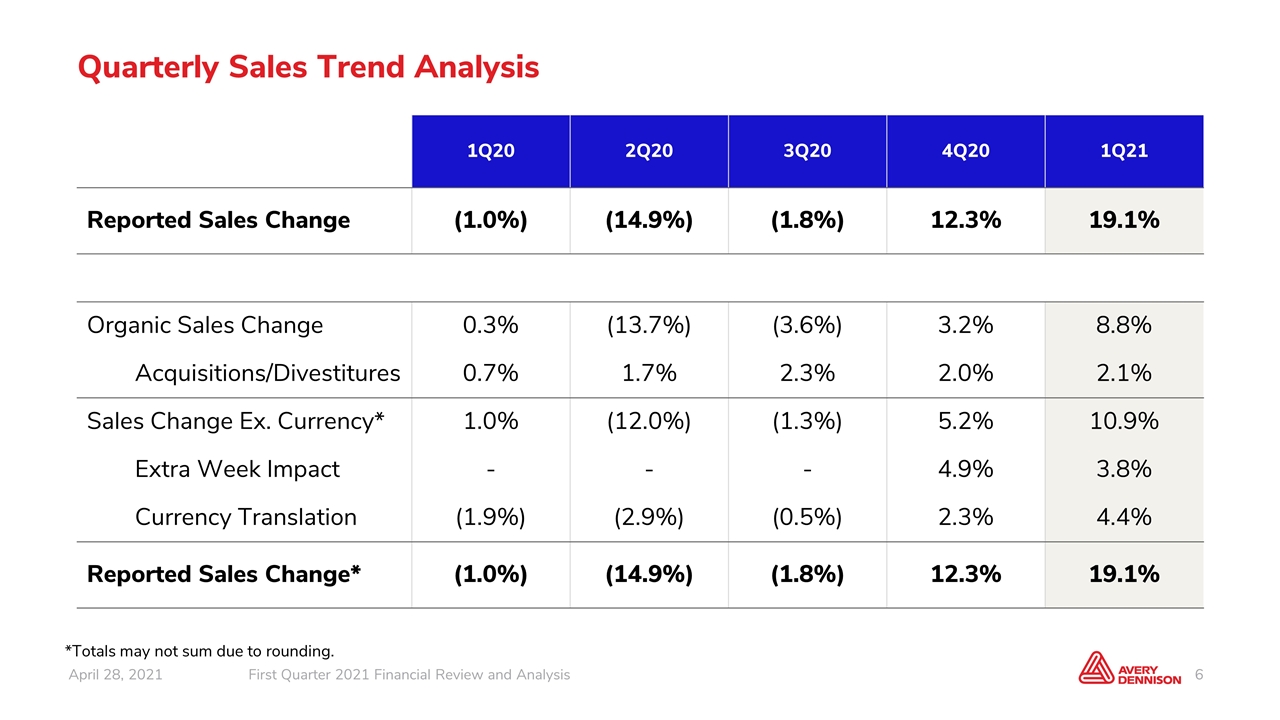
Quarterly Sales Trend Analysis 1Q20 2Q20 3Q20 4Q20 1Q21 Reported Sales Change (1.0%) (14.9%) (1.8%) 12.3% 19.1% Organic Sales Change 0.3% (13.7%) (3.6%) 3.2% 8.8% Acquisitions/Divestitures 0.7% 1.7% 2.3% 2.0% 2.1% Sales Change Ex. Currency* 1.0% (12.0%) (1.3%) 5.2% 10.9% Extra Week Impact - - - 4.9% 3.8% Currency Translation (1.9%) (2.9%) (0.5%) 2.3% 4.4% Reported Sales Change* (1.0%) (14.9%) (1.8%) 12.3% 19.1% *Totals may not sum due to rounding.
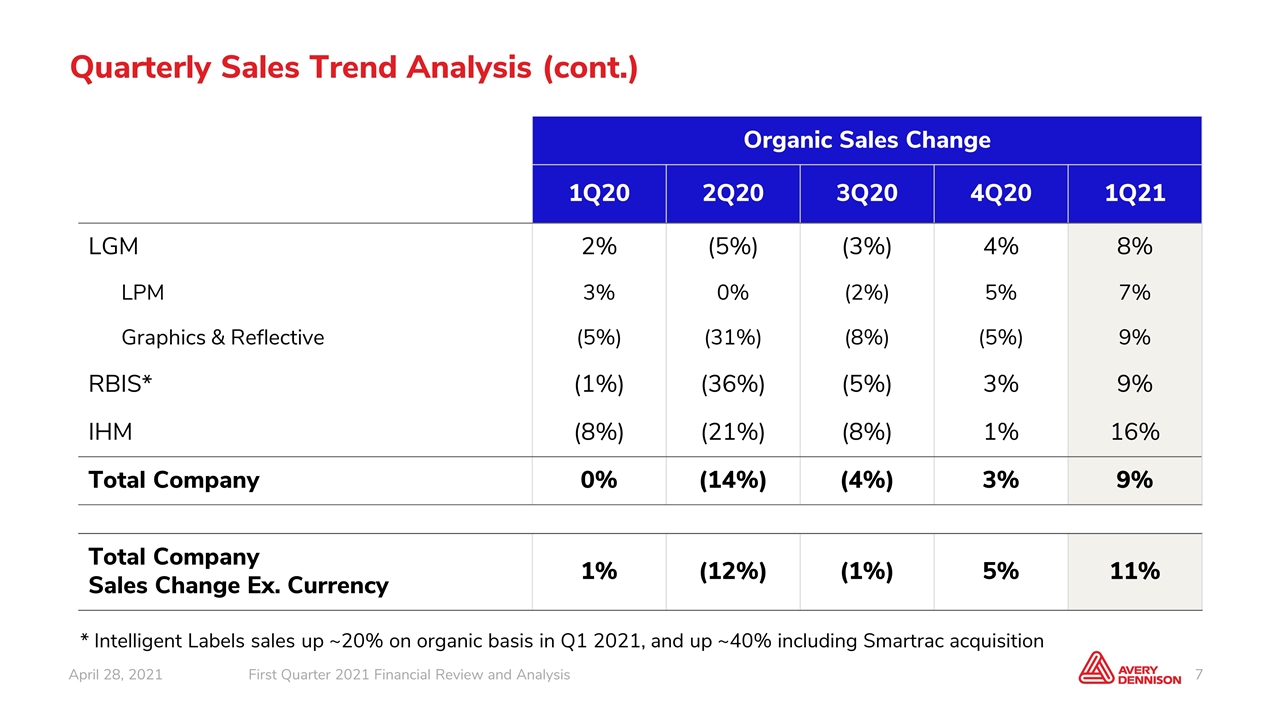
Organic Sales Change 1Q20 2Q20 3Q20 4Q20 1Q21 LGM 2% (5%) (3%) 4% 8% LPM 3% 0% (2%) 5% 7% Graphics & Reflective (5%) (31%) (8%) (5%) 9% RBIS* (1%) (36%) (5%) 3% 9% IHM (8%) (21%) (8%) 1% 16% Total Company 0% (14%) (4%) 3% 9% Total Company Sales Change Ex. Currency 1% (12%) (1%) 5% 11% Quarterly Sales Trend Analysis (cont.) * Intelligent Labels sales up ~20% on organic basis in Q1 2021, and up ~40% including Smartrac acquisition

First Quarter Sales Growth and Operating Margin Comparison Operating Margin Reported Operating Margin Adj. (Non-GAAP) EBITDA Margin Adj. (Non-GAAP) 1Q21 1Q20 1Q21 1Q20 1Q21 1Q20 Label and Graphic Materials 16.4% 14.7% 16.3% 14.8% 18.4% 17.0% Retail Branding and Information Solutions 12.4% 7.7% 12.9% 8.5% 16.7% 12.2% Industrial and Healthcare Materials 12.3% 10.1% 12.3% 10.4% 15.9% 14.8% Total Company 13.8% 11.6% 13.9% 11.8% 16.5% 14.6% Sales Growth 1Q21 Reported Ex. Currency Organic Label and Graphic Materials 17.3% 8.4% 7.6% Retail Branding and Information Solutions 20.1% 15.0% 9.3% Industrial and Healthcare Materials 29.8% 18.8% 16.3% Total Company 19.1% 10.9% 8.8%

Label and Graphic Materials Reported sales increased 17.3% to $1.38 bil. Sales were up 8.4% ex. currency and 7.6% organically Label and Packaging Materials up ~7% organically, with strong growth in both the high value product categories and the base business Combined Graphics and Reflective Solutions up ~9% organically North America and Western Europe up low-single digits organically; emerging markets up mid-teens Reported operating margin increased 170 bps to 16.4% Adjusted operating margin increased 150 bps to 16.3%, as the benefits from higher volume/mix, lower receivables reserves and productivity more than offset higher employee-related costs and the net impact of pricing and raw material costs 2020 Sales by Product Base (Label & Graphics) Specialty/Durables Labels Specialty Graphics Reflectives 2020 Sales by Geography U.S. & Canada Western Europe E. Europe & MENA Asia Pacific Latin America High Value Categories ~32% Emerging Markets ~40% First Quarter 2021 Results End Market Product Category
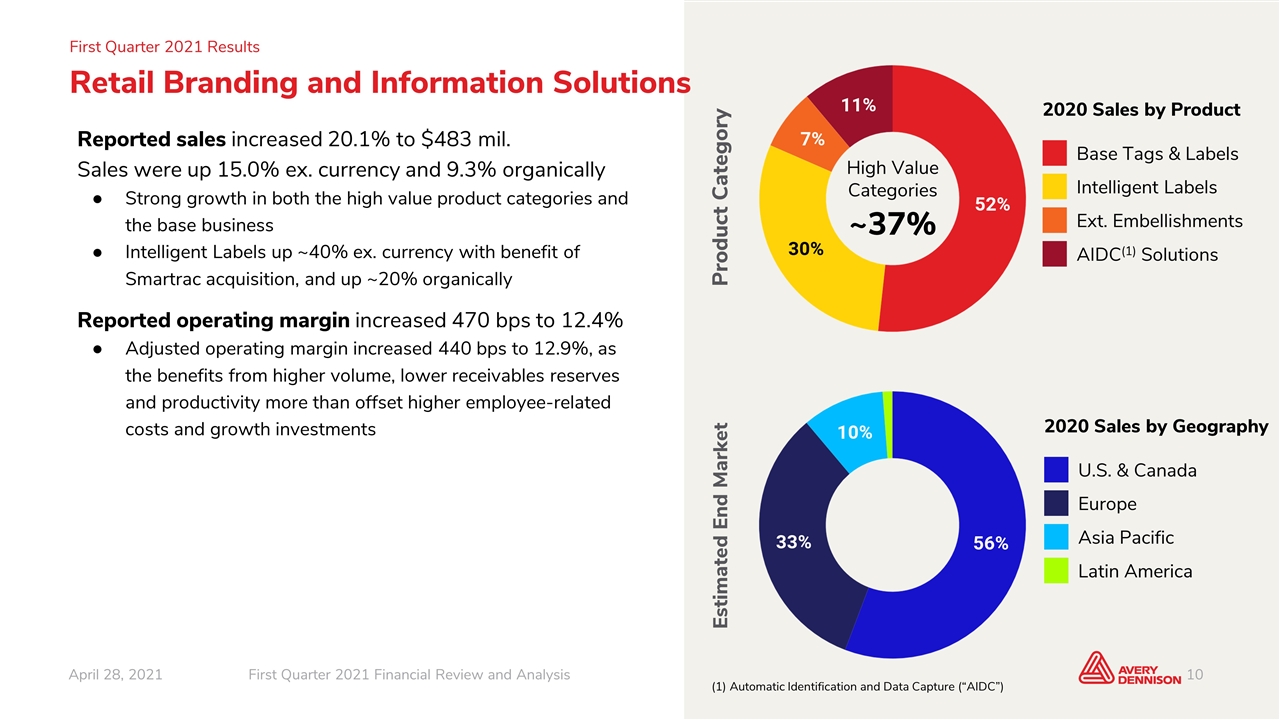
Retail Branding and Information Solutions Reported sales increased 20.1% to $483 mil. Sales were up 15.0% ex. currency and 9.3% organically Strong growth in both the high value product categories and the base business Intelligent Labels up ~40% ex. currency with benefit of Smartrac acquisition, and up ~20% organically Reported operating margin increased 470 bps to 12.4% Adjusted operating margin increased 440 bps to 12.9%, as the benefits from higher volume, lower receivables reserves and productivity more than offset higher employee-related costs and growth investments 2020 Sales by Product Base Tags & Labels Intelligent Labels Ext. Embellishments AIDC(1) Solutions First Quarter 2021 Results 2020 Sales by Geography U.S. & Canada Europe Asia Pacific Latin America Estimated End Market Product Category High Value Categories ~37% (1) Automatic Identification and Data Capture (“AIDC”)
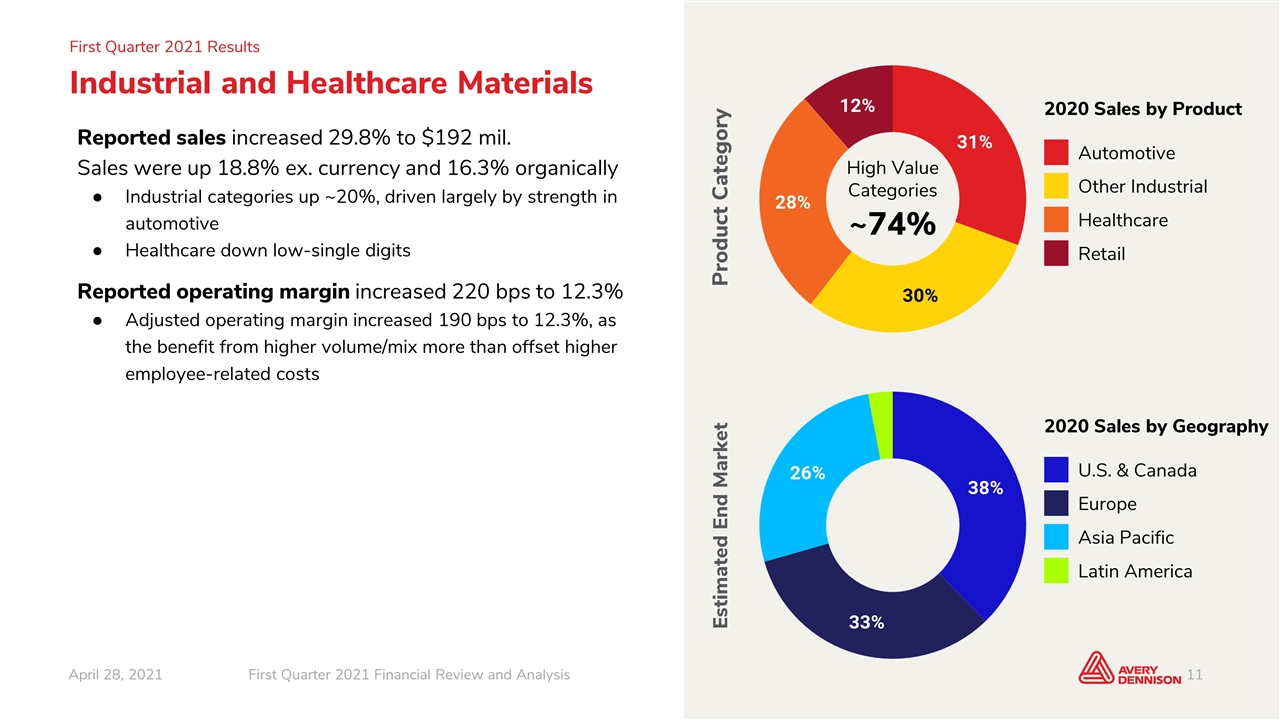
Industrial and Healthcare Materials Reported sales increased 29.8% to $192 mil. Sales were up 18.8% ex. currency and 16.3% organically Industrial categories up ~20%, driven largely by strength in automotive Healthcare down low-single digits Reported operating margin increased 220 bps to 12.3% Adjusted operating margin increased 190 bps to 12.3%, as the benefit from higher volume/mix more than offset higher employee-related costs 2020 Sales by Product Automotive Other Industrial Healthcare Retail 2020 Sales by Geography U.S. & Canada Europe Asia Pacific Latin America First Quarter 2021 Results High Value Categories ~74% Estimated End Market Product Category
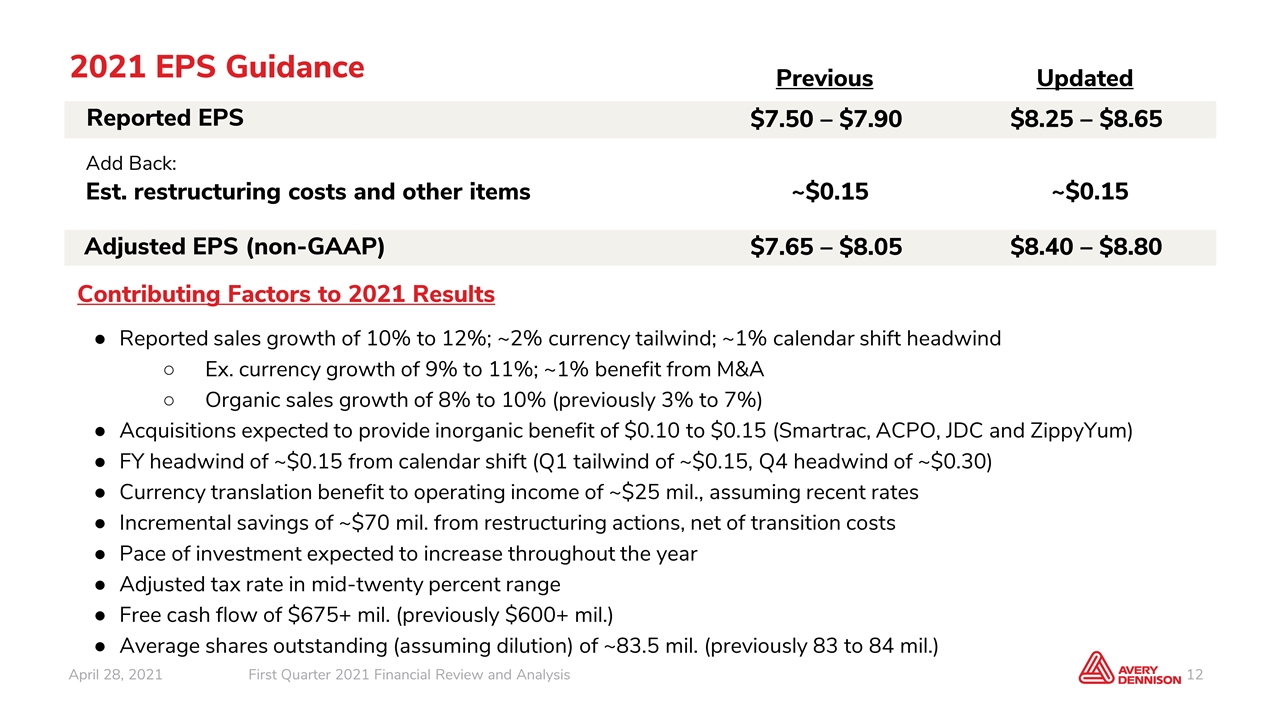
2021 EPS Guidance Add Back: Est. restructuring costs and other items Adjusted EPS (non-GAAP) Reported EPS $8.25 – $8.65 $8.40 – $8.80 Contributing Factors to 2021 Results Reported sales growth of 10% to 12%; ~2% currency tailwind; ~1% calendar shift headwind Ex. currency growth of 9% to 11%; ~1% benefit from M&A Organic sales growth of 8% to 10% (previously 3% to 7%) Acquisitions expected to provide inorganic benefit of $0.10 to $0.15 (Smartrac, ACPO, JDC and ZippyYum) FY headwind of ~$0.15 from calendar shift (Q1 tailwind of ~$0.15, Q4 headwind of ~$0.30) Currency translation benefit to operating income of ~$25 mil., assuming recent rates Incremental savings of ~$70 mil. from restructuring actions, net of transition costs Pace of investment expected to increase throughout the year Adjusted tax rate in mid-twenty percent range Free cash flow of $675+ mil. (previously $600+ mil.) Average shares outstanding (assuming dilution) of ~83.5 mil. (previously 83 to 84 mil.) ~$0.15 Previous Updated $7.50 – $7.90 $7.65 – $8.05 ~$0.15

Thank you
